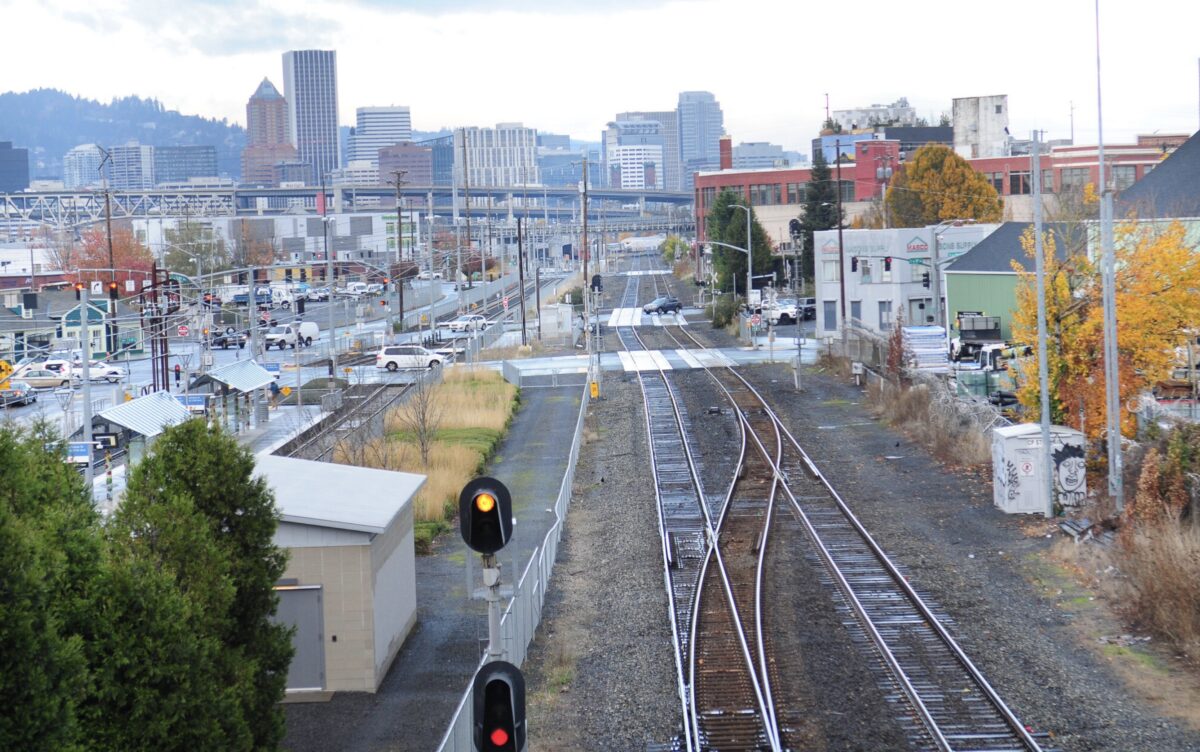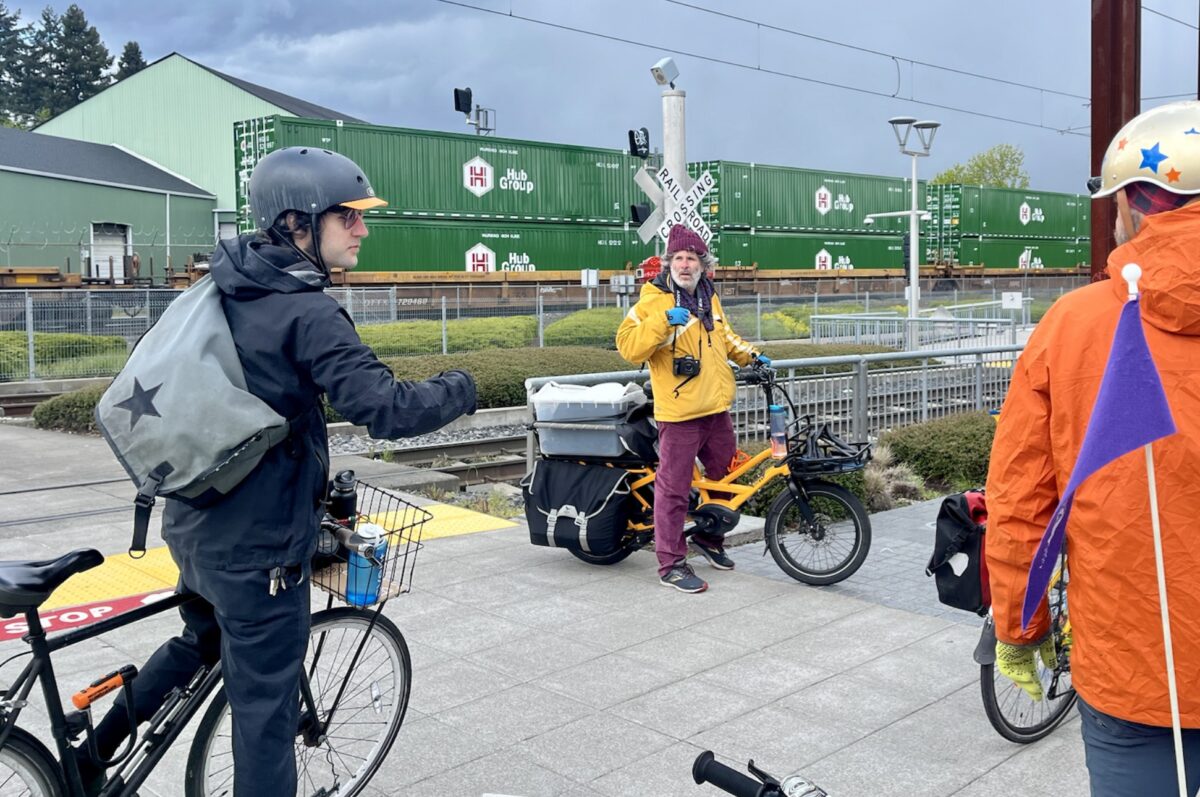 View of the tracks looking west from Bob Stacey Crossing toward SE 12th Avenue and downtown Portland. (Photo: Jonathan Maus/BikePortland)
View of the tracks looking west from Bob Stacey Crossing toward SE 12th Avenue and downtown Portland. (Photo: Jonathan Maus/BikePortland)People are fed up with being at the mercy of Union Pacific trains that rumble through inner southeast Portland every day. The trains create an impenetrable barrier (unless you risk hopping through them) and long traffic delays that have frustrated locals and everyone who uses nearby roads and bike paths for many years. Now, thanks to a new federal grant program with funding to mitigate the impacts of problematic railroad crossings, something might finally give.
The problem
How big of a deal is this? This summer a Brooklyn neighborhood advocate led a Pedalpalooza ride and published a website about it to share tips on how to avoid it.
The tracks come into Portland from the southeast via Brooklyn Yard and follow SE McLoughlin Blvd up to SE 17th Ave, then line up with the Willamette River’s eastern bank until they veer north up to Vancouver (or vice versa). The portion of the tracks north of Powell Blvd and south of Stark St causes the most disruptions, with frequent blockages for people trying to go north-south through the area. Recently, the problem has worsened because of changes in Union Pacific operations to increase train lengths, making it much more difficult to get around them.
This area also lines up with heavily-used bikeways and obstructs what would otherwise be some of the smoothest bike routes in the city. For example, you might have an uninterrupted ride west on the Clinton Street greenway toward the Tilikum Crossing before having to stop at the tracks. People traveling from south of the tracks might have easier access to the Tilikum, but they suffer the same fate when trying to go north.
While people biking and walking have more options for crossing the tracks compared to someone stuck in their car these options aren’t always available. Most notably, the Bob Stacey Overcrossing elevators over the tracks at SE 14th are notoriously unreliable, making it impossible to use for people who can’t climb the stairs and/or life their bikes up them.
People using public transit suffer as well. I’ve watched the MAX orange line train depart from the Clinton and SE 12th Ave station without me because of an unrelenting freight train, and passengers on the TriMet bus lines that run through the area are stuck in the same situation as people in cars. And TriMet’s $175 million Division Transit Project to bring faster bus service to the Division corridor opens next month on a route that will use the Tilikum Crossing to travel from inner southeast to the south waterfront. Major train-related blockages are incompatible with an “express” but route.
“The train blockages encourage unsafe behavior. Drivers might try to beat the gates if they see a train might be sitting there for a long time, and people walking and biking will sometimes hop the trains, which is really unsafe. We have a high level of community concern [about this].”
The advocacy
![]() A train rolling north near Water Ave and SE Taylor Street. (Photo: Taylor Griggs/BikePortland)
A train rolling north near Water Ave and SE Taylor Street. (Photo: Taylor Griggs/BikePortland)
Last year, members of the Central Eastside Industrial Council and Hosford Abernethy and Brooklyn Neighborhood groups put together a Change.org petition asking the Portland Bureau of Transportation to address the frequent train blockages, saying railroad intersections in this area “need major improvements to keep the roads safe for all and easy to commute, and address concerns of increased carbon emissions.”
In the comments section of the Change.org petition, people recounted their experiences waiting at the train tracks with real emotion and said it hurts local businesses and impacts where people decide to live.
“I moved to SE Portland thinking it was a reasonable commute from work. That was because I had been lucky enough to avoid the train the first couple times I visited. Now I plan pretty much every trip around avoiding this train, which adds time driving longer routes or through construction zones. It’s ridiculous. Can’t wait to move out of this area for this reason.” one commenter said.
“This regularly impacts my travel and more recently I am just avoiding this area and nearby businesses altogether due to chance of being stuck behind trains,” another person wrote.
Mobility in the central eastside is on a roll right now with the Oregon Museum of Science and Industry District plan, the new Blumenauer Bridge, and renewed interested in the Green Loop. Unpredictable and long heavy rail crossings could pull the brakes on all that momentum.
The solution?
At Tuesday night’s City of Portland Pedestrian Advisory Committee (PAC) meeting, PBOT planner Zef Wagner said the city hears these concerns and are working to tackle the problem – or at least start to figure out how.
The federal Infrastructure Investment and Jobs Act passed last year includes a grant program for railroad crossing elimination projects across the country, providing funding for “highway-rail or pathway-rail grade crossing improvement projects that focus on improving the safety and mobility of people and goods.” This is a $600 million national competitive grant program with $18 million allocated to planning studies, which PBOT wants to snag $1 million of to conduct the Central Eastside Railroad Crossing Elimination Study.
 Josh Hetrick (in black) led a ride about the tracks back in April. (Photo: Taylor Griggs/BikePortland)
Josh Hetrick (in black) led a ride about the tracks back in April. (Photo: Taylor Griggs/BikePortland)
“We think this would be really competitive for this program, because those train blockages encourage unsafe behavior. Drivers might try to beat the gates if they see a train might be sitting there for a long time, and people walking and biking will sometimes hop the trains, which is really unsafe,” Wagner said at the meeting. “And we have a high level of community concern [about this].”
With this study, PBOT would look at the feasibility of more grade-separated crossings or undercrossings, as well as potential non-infrastructure solutions like wayfinding to give people information ahead of time about when trains are coming. Grant applications are due in early October, and Wagner asked the Bicycle and Pedestrian Advisory Committees to consider writing letters of support for the project.
Brooklyn neighborhood advocate and self-appointed train track crossing educator Josh Hetrick has advocated for more access across the train tracks. He said he sympathizes with people aggravated by this problem and has felt it himself, too.
“When long blockages occur, there are tons of cars idling. Our neighborhood already has some of the worst air quality in the city (due to highways, the rail yard, heavy freight traffic, a TriMet garage, and other industrial sites) and idling emissions just compound that,” Hetrick told me. “It’s just one more thing to deal with each time you leave the house and need to cross the tracks. You don’t have to wonder ‘Can I use the road today?’ with most other roads.”
Taylor has been BikePortland’s staff writer since November 2021. She has also written for Street Roots and Eugene Weekly. Contact her at This email address is being protected from spambots. You need JavaScript enabled to view it.


